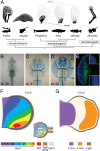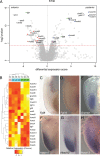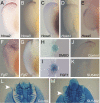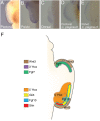Molecular mechanisms underlying the exceptional adaptations of batoid fins
- PMID: 26644578
- PMCID: PMC4702995
- DOI: 10.1073/pnas.1521818112
Molecular mechanisms underlying the exceptional adaptations of batoid fins
Abstract
Extreme novelties in the shape and size of paired fins are exemplified by extinct and extant cartilaginous and bony fishes. Pectoral fins of skates and rays, such as the little skate (Batoid, Leucoraja erinacea), show a strikingly unique morphology where the pectoral fin extends anteriorly to ultimately fuse with the head. This results in a morphology that essentially surrounds the body and is associated with the evolution of novel swimming mechanisms in the group. In an approach that extends from RNA sequencing to in situ hybridization to functional assays, we show that anterior and posterior portions of the pectoral fin have different genetic underpinnings: canonical genes of appendage development control posterior fin development via an apical ectodermal ridge (AER), whereas an alternative Homeobox (Hox)-Fibroblast growth factor (Fgf)-Wingless type MMTV integration site family (Wnt) genetic module in the anterior region creates an AER-like structure that drives anterior fin expansion. Finally, we show that GLI family zinc finger 3 (Gli3), which is an anterior repressor of tetrapod digits, is expressed in the posterior half of the pectoral fin of skate, shark, and zebrafish but in the anterior side of the pelvic fin. Taken together, these data point to both highly derived and deeply ancestral patterns of gene expression in skate pectoral fins, shedding light on the molecular mechanisms behind the evolution of novel fin morphologies.
Keywords: AER; development; evolution; fin; skate.
Conflict of interest statement
The authors declare no conflict of interest.
Figures





References
-
- Alfred Sherwood Romer . The Vertebrate Body. WB Saunders; Philadelphia: 1949.
-
- Nelson JS. Fishes of the World. 4th Ed Wiley; New Jersey: 2006.
-
- Janvier P. Early Vertebrates. Clarendon Press; Oxford: 1996.
-
- Aschliman NC, et al. Body plan convergence in the evolution of skates and rays (Chondrichthyes: Batoidea) Mol Phylogenet Evol. 2012;63(1):28–42. - PubMed
-
- Maxwell EE, Fröbisch NB, Heppleston AC. Variability and conservation in late chondrichthyan development: Ontogeny of the winter skate (Leucoraja ocellata) Anat Rec (Hoboken) 2008;291(9):1079–1087. - PubMed
Publication types
MeSH terms
Substances
Associated data
- Actions
- Actions
Grants and funding
LinkOut - more resources
Full Text Sources
Other Literature Sources
Molecular Biology Databases
Research Materials

